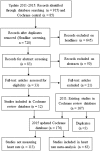Reduced Dietary Sodium Intake Increases Heart Rate. A Meta-Analysis of 63 Randomized Controlled Trials Including 72 Study Populations
- PMID: 27047393
- PMCID: PMC4805644
- DOI: 10.3389/fphys.2016.00111
Reduced Dietary Sodium Intake Increases Heart Rate. A Meta-Analysis of 63 Randomized Controlled Trials Including 72 Study Populations
Abstract
Reduced dietary sodium intake (sodium reduction) increases heart rate in some studies of animals and humans. As heart rate is independently associated with the development of heart failure and increased risk of premature death a potential increase in heart rate could be a harmful side-effect of sodium reduction. The purpose of the present meta-analysis was to investigate the effect of sodium reduction on heart rate. Relevant studies were retrieved from an updated pool of 176 randomized controlled trials (RCTs) published in the period 1973-2014. Sixty-three of the RCTs including 72 study populations reported data on heart rate. In a meta-analysis of these data sodium reduction increased heart rate with 1.65 beats per minute [95% CI: 1.19, 2.11], p < 0.00001, corresponding to 2.4% of the baseline heart rate. This effect was independent of baseline blood pressure. In conclusion sodium reduction increases heart rate by as much (2.4%) as it decreases blood pressure (2.5%). This side-effect, which may cause harmful health effects, contributes to the need for a revision of the present dietary guidelines.
Keywords: blood pressure; dietary sodium; heart rate; meta-analysis; side-effect.
Figures
References
-
- Bruun N. E., Skøtt P., Nielsen M. D., Rasmussen S., Schütten H. J., Leth A., et al. . (1990). Normal renal tubular response to changes of sodium intake in hypertensive man. J. Hypertens 8, 219–227. - PubMed
-
- Cochrane Collaboration (2011). Review Manager (RevMan) (Computer program) Version 5.1. Copenhagen: The Nordic Cochrane Centre.
LinkOut - more resources
Full Text Sources
Other Literature Sources
Research Materials



